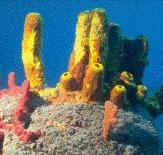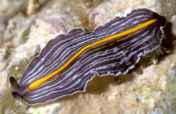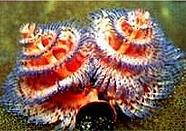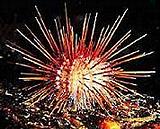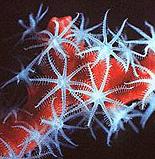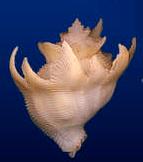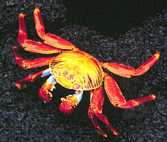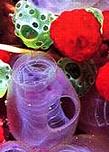Zoology 250 Phylogenetic Trees (2004)
========================================== Porifera (sponges)
|
| =================================== Cnidaria (jellyfish, anemones, corals, etc.)
| |
| | ================================ Ctenophora (comb-jellies)
| | |
| | | ======================== Platyhelminthes (flatworms, tapeworms,etc.)
| | | |
| | | | =(branch uncertain)= Aschelminthes (nematodes, rotifers,etc.)
| | | | |
<<=M=| | | =P==| | ================ Nemertea (ribbon worms)
| | | | | | |
| | | | | | | ======= Mollusca (snails, clams, squids, etc.)
| =E==| | | =A==| | ======|
| | | | | | | | ======= Sipuncula(peanut worms)
| | | | | =C==| |
| | | | | | | ==== Annelida (segmented worms)
| | | | | ===| ===|
| | | | | | ===| ==== Pogonophora (beard worms, vent worms; now put in the Annelida)
| | ===| | | | |
| | | | ===| ======= Echiura (proboscis worms)
| | | | |
===| | | | ======= Onychophora (velvet worms)
| | | ===|
| | | | ==== Tardigrada (water bears)
| | | P-PROTOSTOMIA ===|
| =B==| D-DEUTEROSTOMIA ==== Arthropoda (insects, spiders, crabs, etc.)
| |
| | ===================== Chaetognatha (arrow worms)
| | |
| | |==================== lophophorates (bryozoans, brachiopods, etc.)
| | |
| ==DA===| ============ Echinodermata (starfish, urchins, etc.)
| | ===|
| ======| ============ Hemichordata (acorn worms, pterobranchs)
| |
| =============== Chordata (sea squirts, vertebrates, etc.)
|
======(phyla of uncertain affinity)==== Placozoa, Monoblastozoa, Rhomobozoa, Orthonectida
TRAITS SUPPORTING EACH CLADE (** plesiomorphic- a primitive state, not unique to clade):
M (Metazoa):
a) true multicellularity (no endoderm, no true gut)
b) radial symmetry**
c) monociliated cells**
d) radial, indeterminate cleavage
e) blastula stage larva
f) diplosome**
g) type IV collagen
E (Eumetazoa):
a) true tissues, basal lamina beneath epidermis
b) diploblastic organization
c) gastrula stage
d) blind gut (no anus)
e) true gonads
f) true nervous system with synapses)
B (Bilateria):
a) bilateral symmetry
b) cephalization
c) triploblastic organization (extensive mesoderm)
d) organ-system level of organization
e) protonephridia
|
P (Protostomia):
a) spiral, determinate cleavage
b) mesoderm from single (mesentoblast) cell
c) fate of first germ cell set at 5th cleavage
d) mouth (and sometimes anus) from blastopore
e) sheets of subepidermal muscles
f) multiciliated cells
A: anus present (i.e., complete gut)
C (Coelomate Protostomes):
a) coelom via schizocoely
b) trochophore-like larva with apical cilia
c) larvae swim with compound cilia
D (Deuterostomia):
a) radial, indeterminate cleavage**
b) mesoderm from epithelial cells
c) coelom via enterocoely
d) blastopore yields anus
e) tripartite coelom & body plan
f) monociliated cells**
|
*NOTE: The tree above represents a very classical view of animal relationships. Recent molecular data are raising questions about many of these relationships, particularly among the bilaterian taxa. For an alternative view and discussion see the Metazoa systematics page of the University of California Museum of Paleontology.
Important differences include:
- possible paraphyly of the Porifera
- placement of the Ctenophora basal to the Cnidaria
- possible paraphyly of the Platyhelminthes
- splitting of the Protostomia into two major clades: Lophotrochozoa (composed of two clades: lophophore bearing animals and animals having a trochophore larva) and the Ecdysozoa (clade of molting animals)
- placement of the lophophorates with other protostomes in the Lophotrochozoa instead of in the Deuterostomia
- placement of several of the aschelminth (pseudocoelomate) phyla into the Ecdysozoa.
Experts continue to disagree about which tree is closest to the true phylogenetic tree of animal life, which means we have much yet to learn about how molecules and morphology evolve, and about which kind of evidence provides more valuable clues about animal relations. Beware trees that do not show well-defined synapomorphies.
Return to Zool 250 Home Page or try your skill at the Invertebrate Diversity Quiz.
Copyright © 2004 by A. Richard Palmer. All rights reserved.
(revised Dec. 23, 2003)
